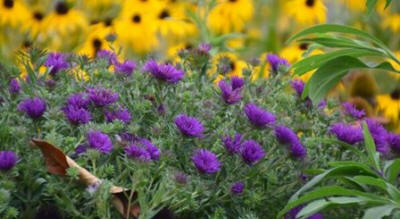|
 University
of Illinois Extension University
of Illinois Extension
Add fall bloomers to the garden
 Send a link to a friend
Send a link to a friend
[September 04, 2024]
Adding flowers that bloom later in the season
provides resources to pollinators into the fall. As they prepare for
migration or overwintering, this is a critical season to ensure they
have the required resources. |
|
 Native
plants are an excellent way to ensure that the blooms have the
necessary pollen and nectar available at the right time. Native
plants are an excellent way to ensure that the blooms have the
necessary pollen and nectar available at the right time.
Asters
Asters have cheery yellow centers with finely textured ray petals
that bloom in various colors throughout fall. New England asters (Symphyotrichum
novae-angliae) have lovely deep purple or pink flowers for a burst
of color in garden beds. Sky blue aster (Symphyotrichum
oolentangiense), aromatic aster (Symphyotrichum oblongifolium), and
smooth blue aster (Symphyotrichum laeve) produce blue to lavender
flowers throughout the fall that last into November. Shortís aster (Symphyotrichum
shortii) and white wood aster (Eurybia divaricata) have
light-colored flowers to contrast with the darker colors of fall.
Most Illinois native asters can tolerate partial shade, adding
floral resources even in places with limited sunlight.

Goldenrod
Goldenrod is a beautiful fall bloomer that provides quality
resources for pollinators. While it often gets blamed for allergies,
itís ragweed that contributes to the airborne pollen which triggers
hay fever in the fall. Showy goldenrod (Solidago speciosa) has
bright yellow blooms on a red stem and is a slower spreader than
other solidago species. The yellow goldenrod blooming with the
purple of the New England aster provides a visually appealing
contrast of color.
Goldenrod is one of the keystone perennial plants in Central
Illinois. It provides resources for pollinators throughout their
lifecycle. Over 50 species of butterflies and moths can use
goldenrod as a host plant. [to top of second
column] |

Pink in the fall garden
When we think of the color of fall flowers, reds, golds, and oranges
come to mind. Lavender and pink flowers are more unusual at this
time of the year. Rough blazing star (Liatris aspera), obedient
plant(Physostegia virginiana), and rose turtlehead(Chelone obliqua)
add a unique splash of color to the garden in late summer to fall.
Having a variety of colors, flower shapes, and bloom time ensures
that resources are available to many pollinator species.
Native grasses
In the fall, native grasses can become a focal feature of any
garden. Their wispy seedheads and beautiful fall colors add a
different texture to the garden. Native grasses provide nutritious
seeds for migrating birds. They also provide shelter and
overwintering sites for pollinators. Little bluestem (Schizachyrium
scoparium) and prairie dropseed(Sporobolus heterolepis) are native
grasses that fit nicely into a home landscape and add interest late
in the season.
Fall bloomers add beauty to the garden as we move into winter and
provide important pollen and nectar resources for pollinators who
are preparing for colder temperatures. Explore more about native
plants and the pollinators they support at the Illinois Pollinator
website. [SOURCE: Nicole
Flowers-Kimmerle, Horticulture Educator, University of Illinois
Extension]

|